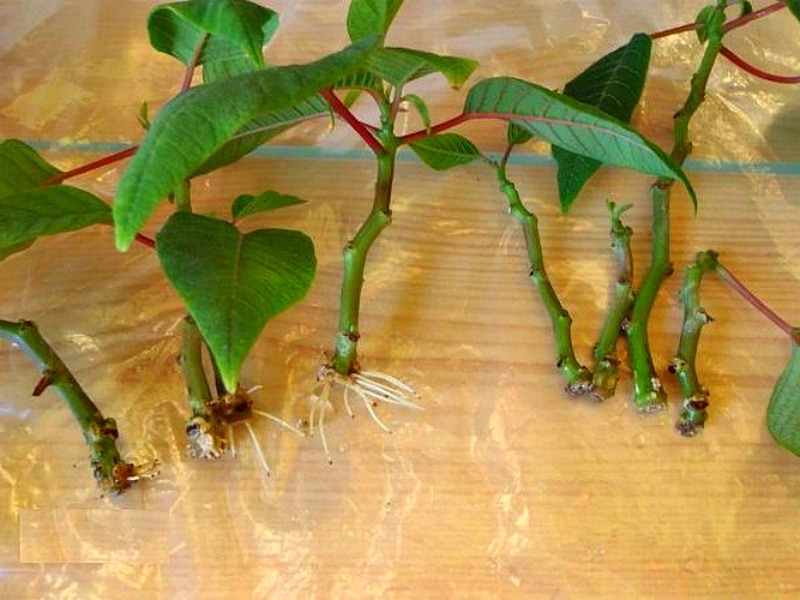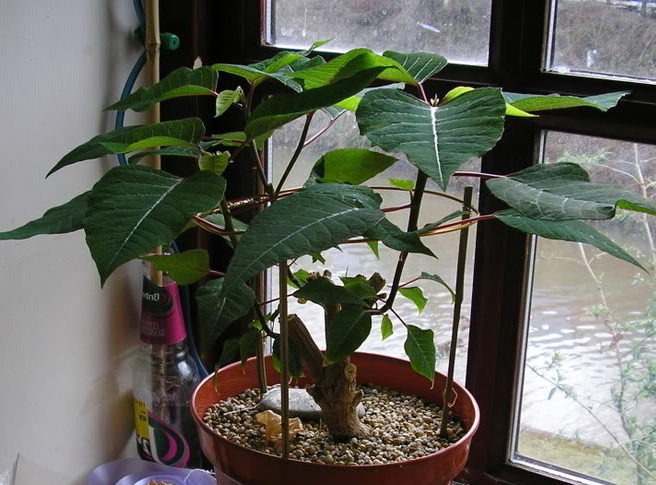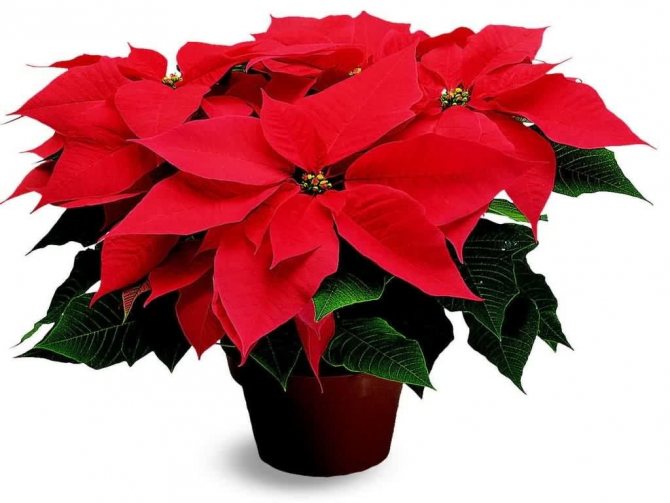Poinsettia care at home

When growing the most beautiful milkweed, you need to pay attention to the placement of the pot with the plant. Direct sunlight, drafts and dry air often cause problems
During the period of active development and growth, it is imperative to observe the temperature regime - thermometer readings from 18ºC to 25ºC. When the period of rest and rest comes, it is better to lower it to 12-14ºC. When the plant blooms, temperatures between 14ºC and 16ºC will return to normal.

Cyclamen: species with descriptions and photos, planting and care at home, reproduction
Watering mode
If the poinsettia grows at home, you need to adhere to moderate watering - water is needed only when the earthen coma dries up. But, in the summer season, the normal frequency is 2-3 times in 7 days. In winter, the plant needs to be watered less often - the poinsettia takes less moisture on itself and it evaporates less from the soil. All water that accumulates in the pan must be poured out - stagnant liquid will lead to decay of the milkweed root system.
Attention! When the indoor air is dry, you should often spray the plant with a spray bottle. Water, for this procedure, as well as for irrigation, must be separated and warm
Spraying will protect the plant from drying out and the appearance of a spider mite.
Top dressing

During the period of active growth and development, the poinsettia must be fed with full-fledged mineral fertilizers. Breaks between feeding procedures should be left for 15 days. When the most beautiful euphorbia produces buds, it also needs to be fed, but fertilizers are replaced with potassium-containing compounds. When flowering, the procedure is not necessary, but the flowers last longer.
Trimming poinsettia
Before trimming the poinsettia at home when leaving, prepare sharp scissors after disinfection. In early April, you need to shorten all the branches of the plant to 15 cm and sprinkle the cut with activated carbon. The second procedure is carried out only after transplanting and the appearance of young shoots - the old branches are cut to a minimum, and the new ones are slightly shortened, forming a neat bush. Cut shoots can be used to propagate poinsettia.
Poinsettia after flowering
The beginning of the dormant period for this beautiful plant falls in the spring season - March or April. The duration of rest at the poinsettia is about 45 days. When the foliage has completely fallen off and the stems are trimmed, the pot is rearranged in a dark place - the soil must be maintained in a slightly moist state. At the end of April, beginning of May, the spurge will begin to recover - then it can be transplanted.
Preparing for flowering. What is a dormant period?
The flowering of milkweed ends in February. This is followed by a dormant period of the plant. Young green leaves begin to appear on the flower, and the bracts fall off. In order for this period to pass calmly, you need:
- Cut off the stems to 10-15 cm. Leave a few buds on each.
- Remove excess shoots, giving the plant the correct shape.
- Move the pot to a cool place.
- Reduce watering the plants to once every 10 days.
- Stop feeding the flower.
In this state, the poinsettia will stay for about two months. As soon as new shoots begin to grow, the flower needs to be moved to a warm place.
Problems and pests: what to do?
The Christmas star-shaped beauty is a noble lady, and therefore, at the slightest malaise, she lets you know about her problems and ailments, you just have to take a closer look at her.
Several common problems and how to solve them:
Sudden falling of leaves. There may be several reasons - natural discharge before a dormant period (see the timing), dry air, draft (close the vents or remove the pot from the wind line), freezing (nothing can be done - cut, and everything that can be saved, propagated again), little light (provide more). But the most common reason is dry air, and it is easy to solve this moment: you need to spray the leaves more often.

The problem of lack of light can be solved with artificial light sources.
Leaves turn yellow or brown and dry around the edges.This means that the soil is saline, which, in addition to the already described external signs, is covered with a whitish bloom. It is necessary to loosen the soil more and stop fertilizing, and by the period of planting or transplanting, improve drainage.

Healthy poinsettia leaves are deep green and elliptical
Holes in the leaves. This is a lack of molybdenum and a disturbed level of acid balance. You can gently add some ash or lime to the ground.

Holes in poinsettia leaves are a common problem
Spots and discoloration. This is a mutation that occurs when a plant grows at the wrong temperature and inappropriate humidity. Such individuals with an uneven color, not typical for the declared variety, are called chimeras.
- "Marble" leaves. This is a virus spread by sucking pests, it is also called mosaic. It cannot be treated, and, alas, in this case the plant cannot be saved.
- Rot. It is root, stem, and can vary in color from gray to brown. It can also be identified by the softening and stratification of the root system. They are treated with fungicides, which are available in gardening stores.
- Powdery mildew. This is a white bloom on the leaves, underneath all tissues turn brown and gradually die off. A special range of fungicides such as "Skor", "Topsin", etc. are used, which will be selected for you in specialized stores.
- Enations are strange outgrowths, scales. Scientists have been unable to find a reason. Perhaps such outgrowths appear from low temperatures, but this is not certain. Rather, it is from the category of genetic mutations that cannot be removed, but they do not bring any particular harm to the plant.
- Punctures on the leaves, around which the fabric curls. These are pests, they are destroyed with insecticides.
- Mealy scale insects. These are white pests, which are removed with a swab dipped in alcohol, or washed with soapy water.
- Bracts die off. This is due to a lack of calcium - it is necessary to water the euphorbia with a solution of calcium.
- Spider mite. Formed due to dry air on the underside of the leaves, they fade and turn yellow. Spray with a solution of green soap, and if it does not help, apply acaricides.
- Whitefly - a whitish moth begins to flutter around, lives on the lower surface of the leaf. Spray with insecticides.
- Black velvety bloom. It is sooty flexible, indicating the presence of sucking parasites, on the secretions of which it exists, destroying the process of photosynthesis. Here it is necessary to calculate what kind of pests are, and to deal with them already.

Proper care and timely disposal of pests is the key to the beauty of the plant.

Comfortable conditions for poinsettia can be created in any home
A gentle, unusual foreign lady who must be carefully accustomed to your yard is what poinsettia is, caring for which at home is not as difficult as many information sources scare us. If you have a good memory, discipline and sensitivity to those whom you have tamed, the "Christmas star" will find a common language with you and will delight you and your guests with its exotic beauty for many years
It is enough to study the rules well and pay due attention!
Legend and history
Many legends and tales have been preserved about this amazing plant. According to this legend, the Christmas Star owes its name to children from a poor family. Traditionally, the Mexican poor would bring offerings to the newborn on Christmas Eve. But the children had nothing to give. Then they collected wild herbs, which magically turned into fabulously beautiful flowers at the cradle.

But the poinsettia flower was named after Joel Poinsett. The American ambassador to Mexico was an enthusiastic person, he was interested in the flora of the tropics. In 1825, he was the first to bring this brightly colored twig to one of the American states.
The cuttings successfully took root, and Joel gave the plant the name euphorbia, after the name of the ancient philosopher and healer. But the people stubbornly stuck with the name poinsettia, which came from the name of the ambassador.
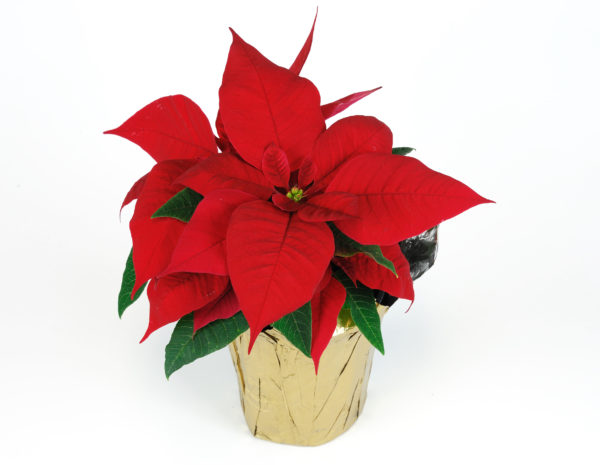
In the tropical forests of its homeland, this euphorbia shrub reaches a height of three meters.
In the new habitat, poinsettia does not reach such an impressive size and a small flowerpot is enough for it.
Thanks to breeding work, many different varieties of milkweed have recently appeared. Their leaves of white, cream, pink, crimson, spotted color form an exquisite flower shape that resembles a star. But poinsettia, with its classic red leaf color, is still the leader among Christmas plants.
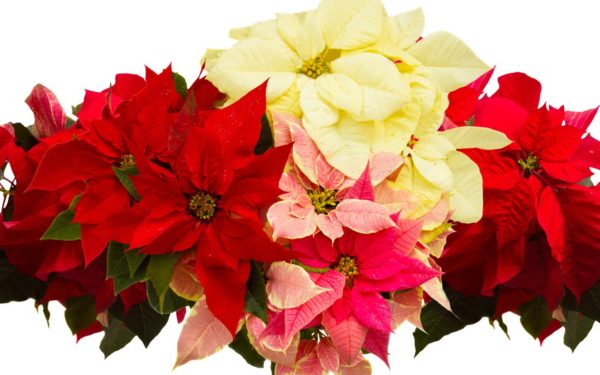
Euphorbia is often used as a seasonal green home decoration. Many consider this plant to be an annual and make no effort to preserve the flower. But by properly caring for poinsettia at home, you can annually rejoice at the miraculous transformation of the Star of Bethlehem.
Reproduction of poinsettia at home
At home, in the tropical forests, poinsettia reproduces by seeds. Falling to the ground, they give numerous shoots. But with artificial breeding, this option is not the most successful. All varieties of the finest milkweed, which breeders are proud of, are the result of their many years of work.
The seeds of these plants do not retain varietal characteristics. The samples obtained are not so bright and colorful, in addition, their juice is quite poisonous. To achieve the reproduction of a tropical plant by seeds is not only meaningless, but also quite unacceptable because of the danger.

There remains a way of vegetative propagation. At home, propagating a wondrous plant by cuttings is quite easy. The upper part with five to six buds is cut off from the elongated shoot. The cutting should be soaked in water at room temperature, then dried and powdered with activated charcoal. Plant several processed branches in a pot. After rooting, you will get a lush, beautiful bush that does not require careful maintenance.
Important!
The part of the plant planted for rooting should not go deeper than a centimeter into the ground.
In the video, you can get acquainted with the care, trimming, transplanting of poinsettia at home after purchase.
Poinsettia care at home
How to care for poinsettia
Poinsettia loves to live on the western or eastern windows, but the direct rays of the sun harm her, as well as drafts. The most comfortable temperature for plant growth is 18-25 ºC, during flowering - 16-14 ºC, and during the rest period - 14-12 ºC. Watering in the summer should be abundant; in winter, watering is reduced so that the soil is barely wet. When the Christmas poinsettia blooms, start spraying it with lukewarm, standing water.
Poinsettia feeding
It is necessary to feed the poinsettia from spring to autumn twice a month with complex mineral fertilizers. During the flowering period, you will need potash fertilizers, although many growers are superstitious in this matter and prefer not to fertilize the plant during the flowering period.
In the photo: Pink poinsettia
Poinsettia transplant
The poinsettia is transplanted in the spring, in April or May, after a dormant period, when young leaves appear on the awakened poinsettia. The soil should be slightly acidic, consisting of leaf, clay-sod, peat soil and sand in a ratio of 2: 3: 1: 1. Don't forget about the drainage layer. The pot should not be much larger than the previous one. To minimize the stress of transplanting a plant, the poinsettia transplant is carried out using a transhipment method.
Trimming poinsettia
There are no special subtleties in how to trim a poinsettia. It is pruned twice: in early April, when a dormant period is expected, to a height of 15 cm from the soil level in the pot, and after transplanting, when new shoots begin to grow in the plant.This is done to form a beautiful bush and remove weak shoots, which are then used as cuttings for vegetative propagation.
In the photo: The variegated poinsettia is about to bloom
Poinsettia: home care
If you brought home a flower, you need to thoroughly study all the rules and learn how to apply them.

The long life of poinsettia directly depends on the care of the plant.
-
-
- The soil. Our Star of Bethlehem will need light soil with adequate drainage. Its roots do not tolerate excess moisture and require a large amount of oxygen, and with too much watering, the plant instantly decays. The normal basis for her life is 3 parts of turf and 2 parts of land for leafy plants, plus sand and peat in equal proportions.
- Light. Poinsettia does not like direct rays of the sun, she needs diffused lighting, in the summer it grows well in gardens, as well as on terraces or balconies, but in their shady part.
-

Choose a place for poinsettia where direct sunlight will not fall on it

Poinsettia is not afraid of fresh air and will become a bright decoration of the garden (define a place for it with diffused lighting)
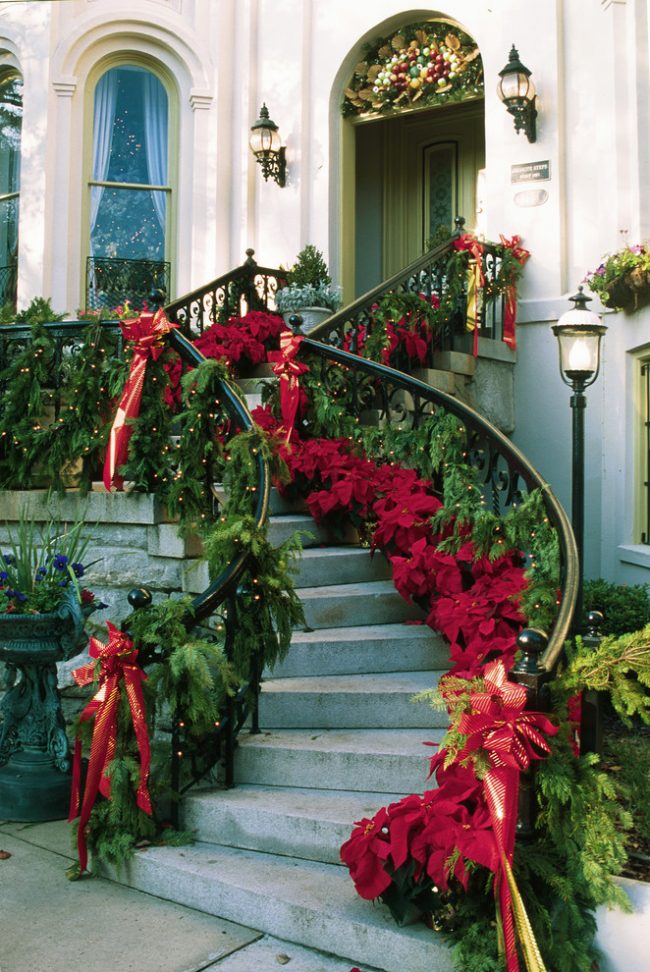
American Tradition - Poinsetting the Entrance Staircase

The main condition for the flowering of poinsettia is a comfortable temperature regime.

It is not recommended to put the poinsettia near the fire or near the fireplace
Advice! If you have dry air at home, but you do not want to give up the dream of growing a poinsettia, it should be sprayed regularly. In this case, the water should be warm.

It will not be difficult to develop a watering regime for a plant.

During flowering, poinsettia requires special care. Therefore, it is worth stocking up on top dressing in the form of potassium and phosphorus.
Poinsettia care at home in winter and late autumn
The yellow flowers themselves are not of particular beauty and aesthetic value, the bracts make up the entire amazing appearance. For their sake, experienced florists have developed a whole system of plant care during its flowering period. The so-called short day regimen is practiced. In November, the beauty is placed in a dungeon - daily kept in the dark for 12 hours so that the kidneys are tied. When dusk falls, the pot is covered with a thick bag or paper, and removed in the morning. This kind of stimulation is carried out for 8 weeks - let's call it a cosmetic procedure that maintains an ideal shape. Thus, after a few weeks, exactly by Christmas, red bracts appear.

A special system of plant care during the flowering period will provide you with bright red poinsettia bracts right for the new year

Yellow poinsettia flowers do not carry aesthetic value
It is much more important to pay attention to her bracts.

Blooming poinsettia will delight you with bright colors in the winter season

Light and temperature are important components in the poinsettia care system
Advice! All flowers are formed only on new shoots, and therefore you will have to continuously grow new ones or rejuvenate old ones.
Care after pruning
After all the manipulations, the spurge rests for about 2 months. Then the first signs of awakening appear. During this period, the plant needs special care.
How to care:
- Provide maximum access to light. Transfer to a warm and bright room.
- Water abundantly after the topsoil is dry. But at the same time, do not allow water to stand in the pan.
- Poinsettia does not tolerate dry air well. It is recommended to purchase a humidifier or hang a wet cloth over radiators.
- Feed with fertilizers intended for flowering plants. During the period of rapid growth, euphorbia is fertilized with solutions with mineral complexes, and during the formation of buds, with the content of potassium and phosphorus.
- Shoots that are too long or weak should be cut off. Then the bush will retain its neat shape.
In order for the plant to bloom for the Christmas holidays, already in September, poinsettia of the night should be artificially created 15 hours long. This means covering the culture with a thick paper cap. Take care of air access. Open after the time has elapsed. In artificial daytime hours (9-10), put the spurge in a well-lit place.
Subject to all the rules, it will bloom at the end of the year.
Important! For two months (usually until May), when the plant is still resting, watering and fertilizing it is not required.
You will learn how to properly care for a poinsettia in this video clip:
Pests and diseases
Diseases appear with improper care. Pests that threaten poinsettia: spider mites, scale insects.
This colorful plant has many names. Officially, it is called the most beautiful euphorbia, and this compliment is well deserved. The common name of poinsettia flower was named after Joel Roberts Poinsett, to whom the whole world owes the popularization of this plant.
As Mexico's first minister, Poinsett was also a physician and an avid botanist. Having discovered a plant from which the Mexican Aztecs extracted dye and milky juice to make a cure for fever, the minister took up the cultivation of a flower in America and generously sent samples to various botanical gardens.
The plant owes its second allegorical name - "Bethlehem" or "Christmas star" - to Albert Ecky, who was engaged in the cultivation of fruits and flowers. It was he who popularized poinsettia as a Christmas flower. After all, it blooms in time for the holiday, dispels the winter twilight with a bright scarlet color and reminds of the scarlet dress of the main Christmas wizard Santa Claus. With the light hand of Ecky, the inhabitants of America began to decorate their homes with poinsettia for Christmas.
Quite often, the double letter "t" in the name of the poinsettia is abbreviated to one - obviously, for ease of spelling. But no matter how they call it, it is impossible to confuse a poinsettia flower with some other. After all, she has a unique appearance.
Poinsettia belongs to the Euphorbia family. Her homeland is the tropics of Mexico and Central America.
The poinsettia Christmas plant is an evergreen shrub. In nature, it can grow up to 4 meters in height, but at home it reaches only 30-50 cm. Its leaves have a classic appearance - ovoid and green in color.
As you can see in the photo, poinsettia flowers are small and yellowish. Modest enough in appearance, they are collected in neat sockets.

However, the main decoration of poinsettia is the bright, traditionally red bracts, which themselves look like flowers. Breeders work with them, who today have bred varieties with white, cream, yellow, bright and tender pink, lilac and even multi-colored bracts.
Often, after flowering, the still young poinsettia dies, but with proper care, its life can be extended for many years.
Potted flowers poinsettia are poisonous
... Their juice is very harmful to the eyes, and if it comes into contact with the skin, it causes irritation or allergies. And if it ends up in the stomach, you can expect vomiting and intestinal upset.
When caring for such an insidious plant, you should take precautions and use rubber gloves. And, of course, keep the beautiful poinsettia away from small children and pets.
Diseases and pests
Leaves may dry out and turn yellow, due to a sharp temperature drop
Among the most common pests of the Christmas star are scale insects, mealybugs, thrips, whiteflies, and spider mites. In this case, a white mass resembling wax, as well as whitish, unpleasant spots, can form on the surface of the leaves.
Special chemical compounds or folk remedies can destroy pests. Here is some of them:
- a soap solution, which should be used to wipe the infected leaves of the flower every week, will help get rid of the scale insects and aphids. After that, the plant is well rinsed under clean water;
- mineral oil will help to destroy the worms.
If folk remedies do not immediately give the desired results, then you need to immediately go to the store for special protective equipment in order to prevent the poinsettia from yellowing.
Diseases include:
- gray rot, which appears due to excessive watering of the plant, as well as high humidity. Signs of its presence are gray, fungal bloom on the stems and brown spots on the leaves. Such drugs as "Skor", "Celandine" and "Fundazol" will help to defeat it;
- fusarium causes complete death of shoots;
- mealy rot covers the flower with bloom. It is white and kills the plant. "Topaz" and "Fitosporin-M" will help to destroy it.
Very often, at home, there is a yellowing of the poinsettia. This is due to the strong flooding of the flower, which is in a cool room for a long time. Such conditions cause root rot, which is manifested by changes in the appearance of the leaves. At the same time, the leaves can turn yellow as a result of very poor watering. As a result, the Christmas star is struck by a tick, which turns the leaves yellow.
Following all the recommendations and advice of experts, carefully watering the flower, avoiding waterlogging, creating optimal temperature conditions for it, as well as pruning it in time, the poinsettia will bloom every year, delighting you with its flowers and colorful leaves.
Watch the video on how to make this plant bloom.
Reproduction of poinsettia at home

At home, poinsettia propagates only by cuttings.
At home, it is not possible to achieve that the plant reproduces by seeds. Therefore, the flower is planted by using cuttings. They are obtained from the shoots cut off at the end of spring (the cut should be at an angle). Their length should not exceed 7-10 cm. At the same time, make sure that there are at least 4 or 6 large buds on the cuttings.
The resulting cuttings are freed from poisonous juice. To do this, they are placed in warm water for 25-35 minutes. Then the sections are treated with a special agent that stimulates the formation of roots. Prepare the soil in containers, which should consist of the following components:
- sand;
- dry manure;
- humus.
At the same time, the soil should be well moistened. Having planted cuttings in it, the container is removed to a bright place (not directly in the sun), covered with a film and kept at a temperature of 24 ° C to 28 ° C. In order not to provoke moldy soil, it is periodically ventilated by raising the protective polyethylene. Every 3-4 days it is gently watered or sprayed with a spray bottle.
A month after the complete rooting of the cuttings, they are freed from the film and allowed to stay at temperatures up to 16 ° C. In September-October, young flowers are planted in pots, the diameter of which should be 20 cm. Such a plant will be able to bloom only after a year.
Poinsettia plant species
Red
Poinsettia name Bordova
speaks for itself. Its lush perianth is of a bright burgundy color. The flower grows to a height of 25 cm.
Poinsettia Variegata
possesses a pink or burgundy perianth. It differs from other representatives in white specks on colored leaves.
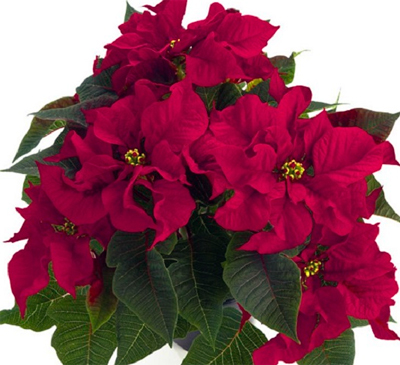
Poinsettia varieties Cortez
Are short but very bushy varieties with white, yellow, cream or pink bracts. Sonora White also has white perianths, but these are marked with an ivory tint.
There are special varieties that are very different from the classic milkweed of the finest. This is, for example, the Marble stargazer with the marbled color of the bracts, or the Winter rose with very large and dense bracts, curved like roses.Creamy strawberries have pink-purple bracts with curly white edges.
New varieties appear regularly, striking fans of this flower with their exquisite and catchy variety.
The price of poinsettia fluctuates in a very wide range. You can find a copy for 160 rubles, you can buy a more expensive poinsettia - for 600-700 rubles
... Found on the windows of city and virtual stores "Christmas flowers" for 1,500 rubles, 2,000 rubles and 2,500 rubles. On professional sites of flower growers, you can find luxurious tall and well-developed specimens in pots for 3,800 rubles.
After the purchase, the transplant of the poinsettia is not required, it will not need fertilizer for the first time either. Caring for a poinsettia after purchase is no different from regular caring for it.
When to buy poinsettia and how to choose a healthy plant

Pounsettia is a great option for growing flowers in winter
If on Christmas you want to please your family with an unusual flower, you need to responsibly approach the purchase. We bring to your attention the main recommendations of specialists on choosing a plant, thanks to which you can purchase a healthy bush and prevent common mistakes.

Red poinsettia is traditionally considered a Christmas flower and is often used for decoration.
Take a good look at the poinsettia leaves and bracts. They should be green-yellow or red, and free of pollen. If in a flower shop you are offered to purchase a plant with yellow leaves and pollen, it is better to refuse the purchase.
These signs indicate that flowering has already begun, so soon the Christmas star will shed bright bracts.
Pay attention to the shape of the bush. It should be even, have a beautiful outline, and the same amount of foliage on all sides.
Make sure that all stems are covered with green leaves and that the bracts are elegantly colored. Often there are cases when the flowers have a greenish tint. This indicates the poor quality of the plant, so you should not purchase it. Depending on the species and variety, poinsettia bracts can be red, yellow, white or pink in color.
Before making a purchase, you must make sure that you have a healthy plant in front of you. It should not have withered, rotting, twisted or diseased leaves. Experts also recommend checking the soil: damp soil, as a rule, indicates an incorrect content or damage to the flower by root rot. Also, be sure to inspect the leaves for insect pests.
The New Year's star does not tolerate crowding, so it is better to give preference to unpackaged plants that stand freely in the display case. Otherwise, fragile leaves may break.
The size of the flower also plays an important role. As a rule, an adult shrub is 2-3 times the size of the pot in which it is planted.
Experts recommend purchasing a Christmas flower exclusively from specialized flower shops. During transportation, he should create favorable conditions. For example, if the air temperature is below + 15 ° C, then the plant should be wrapped in thick paper, placed in a spacious bag or transported in a large box.

There are a variety of types and options for a shade of pounsettia.
By following a few simple rules, you can easily choose a strong and healthy plant.

